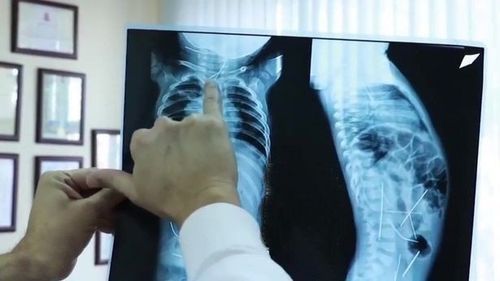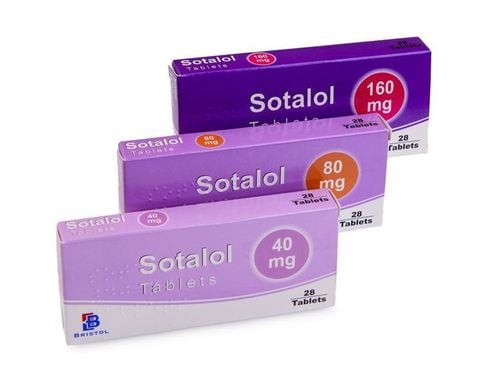This is an automatically translated article.
Article written by Master, Doctor Dao Kim Phuong - Cardiologist and echocardiogram - Department of Examination - Vinmec Times City International Hospital
Infants with cyanosis require immediate evaluation, general supportive care to maintain adequate tissue perfusion and oxygenation, and specific treatment when the underlying cause is known. Specific interventions for newborn cyanotic congenital heart disease (TBS) include the use of prostaglandin E1 (PGE1; also known as alprostadil) and cardiac catheterization or palliative procedures.
3. Initial management
General supportive care: Initial management begins with general care including support and cardiovascular monitoring to ensure adequate oxygenation and perfusion of organs/tissues. If airway compromise is present, an appropriate airway should be established immediately and supportive therapy (eg, supplemental oxygen and/or mechanical ventilation) should be instituted as needed. Patients with hypotension or poor perfusion require CPR.
Vital signs should be monitored and vascular access established for blood sampling and medication administration. Safe venous and arterial catheterization is most easily accomplished through the umbilical vessels. This will allow correction and effective monitoring of acid-base balance, metabolic changes (eg, hypoglycemia, hypocalcemia) and blood pressure. Vasoconstrictor agents such as dopamine or dobutamine may be needed to correct hypotension.
Antibiotics: Sepsis can lead to cyanosis and left ventricular dysfunction or lung disease. As a result, unless another specific etiology is identified promptly, broad-spectrum antibiotics (ampicillin and gentamicin) should be initiated after culture is obtained.
Specific measures for congenital heart disease: In most cases, cyanotic TBS depends on the ductus arteriosus (PDA) for pulmonary or systemic blood flow. Closure of the ductus arteriosus may result in rapid clinical deterioration with severe life-threatening changes (ie, severe metabolic acidosis, convulsions, cardiogenic shock, cardiac arrest, or internal trauma) organs). Therefore, neonates with ductal-dependent lesions are at higher risk of mortality and morbidity unless interventions to maintain ductal patency are initiated for ductal-dependent lesions. vessels, ensuring adequate mixing of deoxygenated blood and oxygen or relieving obstructed blood flow.
Prostaglandin E1: In neonates with or with clinical suspicion of a ductal-dependent congenital heart defect, PGE1 (alprostadil) should be administered until diagnosis or treatment is established.
Dosage - Initial dose depends on clinical condition:
If large ductus arteriosus is known, PGE1 can be initiated initially at a low dose (0.01 mcg/kg per minute). This situation is commonly seen in patients with echocardiography confirming large PDA receiving care in a tertiary center that specializes in the treatment of neonates with cyanotic heart disease. If the ductus arteriosus is restricted or the condition of the drain is unknown, the starting dose is 0.05 mcg/kg per minute. This is the standard dose used in patients requiring transport to a center specialized in the care of neonates with cyanotic heart disease. The dose of prostaglandin may be increased as needed to a maximum dose of 0.1 mcg/kg per minute. The risk of apnea increases with increasing dose of PGE1.
Efficacy: PGE1 is an essential drug in the treatment of neonatal TBS. Although there are no randomized controlled trials, the available observational data strongly support the effectiveness of PGE1 infusion in maintaining ductal patency in neonates with tubular-dependent circulation. artery.
Adverse Effects: Serious adverse effects of PGE1 infusion include:
Apnea: Immediate intubation is required because apnea can occur at any time during the infusion. The risk of apnea increases with increasing dose of PGE1. Hypotension and tachycardia: A separate, reliable intravenous line is required to deliver fluid for resuscitation.

Necrotizing enterocolitis (NEC): Neonates with ductal-dependent cyanotic lesions managed with PGE1 infusion are at increased risk of developing NEC. This mechanism may be related to compromised mesenteric perfusion due to the synergistic effects of cyanosis and low diastolic blood pressure. Thus, NEC is not an adverse effect of PGE1 but rather a consequence of ductus arteriosus maintenance. Neonates receiving PGE1 should be monitored for clinical evidence of NEC (eg, abdominal distention, repeated vomiting, bloody stools). We do not routinely withhold enteral feeds as a preventive measure in term infants receiving PGE1, as the risk of NEC does not appear to be increased with enteral feeding. However, in some cases, it may be prudent to refuse feeding if the infant is to be transported or if the airway is not secured, as intubation may be required if apnea occurs. For infants who are enteral-feeding and have signs of NEC, feeding should be discontinued. Impairment after PGE1 initiation: The clinical deterioration after PGE1 initiation often indicates the presence of rare congenital heart defects associated with pulmonary venous or left atrium obstruction. These include total obstruction (usually an abnormal pulmonary vein connection below the diaphragm) or various conditions associated with restrictive atrial septum (eg, left-sided hypoplastic syndrome [HLHS], triatrial heart disease, severe mitral stenosis or hypoplasia, or D transposition of the great arteries [D-TGA] associated with limited atrial shunting). These patients require urgent echocardiography, followed by cardiac catheterization or surgery.
Transport by PGE1: When it is necessary to transfer an infant receiving PGE1 from the birth hospital to another medical facility with expertise in pediatric cardiology, the care team should anticipate the possibility of apnea during transport . We usually recommend intubation and mechanical ventilation of the infant prior to transport if the infant is receiving PGE1 because of the risk of apnea. However, practice varies and intubation is not routinely performed by all tertiary care transport teams.
In a retrospective study of 300 children with ductal-dependent TBS who underwent transport with PGE1, 3/4 were intubated prior to transport (42% elective, 27% due to renal failure). respiration occurred before the initiation of PGE1 and 5% because apnea occurred after the initiation of PGE1). Of the 78 infants transported without prior intubation, 3% developed clinically significant apnea during transport. Apnea was more likely to occur in children receiving doses of PGE1 ≥ 0.015 mcg/kg per minute.
Cardiac catheterization: Cardiac catheterization interventions can be palliative by ameliorating cyanosis or correcting by easing outflow obstruction.
Balloon ablation can significantly reduce cyanosis in patients with D-TGA associated with limited atrial septal flow and in patients with limited atrial septum associated with left-sided obstructive disease. In patients with D-TGA, this procedure can be performed at the bedside under echocardiography guidance.
Balloon angioplasty may be effective in patients with pulmonary stenosis or critical aortic stenosis. Selected patients with pulmonary hypoplasia are also candidates for balloon angioplasty if the obstruction is membranous, tricuspid annulus, and right ventricular size sufficient to support biventricular repair. and coronary circulation is independent of the right ventricle.
It is also possible to perform closure of a pulmonary AVM through a cardiac catheterization.
4. Summary and recommendations
Cyanotic lesions account for about a third of potentially fatal congenital heart disease (CHD).
Prenatal ultrasound identifies many forms of TBS. However, some cases of cyanotic TBS are not detected before surgery, because the sensitivity of the test is variable and depends on the expertise of the operator, gestational age, fetal location and type of defect.
In neonates with cyanotic TBS not identified prior to surgery, the clinical diagnosis may be suspected based on history, physical findings, pulse oximetry, chest radiograph, and or electrocardiogram (ECG) detection. Diagnosis is confirmed by echocardiography.
History can identify maternal or perinatal conditions and family history of TBS as risk factors for TBS. Physical examination can provide information that helps distinguish TBS from other cyanotic disorders such as respiratory disease or sepsis and may also suggest specific cardiac defects. Physical findings associated with TBS include irregular heart rhythms, heart sounds, pathological murmurs, blood pressure gradients between the upper and lower extremities, and hepatomegaly. The routine use of pulse oximetry in the neonatal period to screen for critical TBS has been shown to be effective for identifying undetected neonates before birth. Chest radiographs can help differentiate cardiac and pulmonary etiologies for neonatal cyanosis. Abnormal findings in the lung field are indicative of a pulmonary cause, while increased heart size, abnormal heart shape, and right aortic arch are indicative of TBS.

The electrocardiogram may be normal in many cases of cyanotic lesions of the neonatal period, although some lesions are associated with specific patterns. With the advent of routine SpO2 testing and improved access to echocardiography, testing for hyperoxygenation is often not needed. Hyperoxygenation testing may be helpful if an echocardiogram is not available. Echocardiography provides a definitive diagnosis of TBS and information on cardiac anatomy and function. Echocardiography should be performed if initial evaluation does not reveal another obvious cause of low oxygen levels (eg, lung disease). Other indications for echocardiography include blood pressure or pulse differential between the upper and lower extremities, an enlarged heart, or a pathological murmur. ● Initial management of a cyanotic infant includes general supportive care to ensure adequate oxygenation and tissue perfusion.
For neonates with ductal-dependent TBS, we recommend prostaglandin E1 (PGE1; alprostadil) until primary therapy is instituted (Grade 1A). PGE1 should be started empiric (ie, before echocardiography confirms the diagnosis) if there is strong clinical suspicion for ductal-dependent TBS based on initial assessment. If it is necessary to transfer an infant with cyanotic TBS who is receiving prostaglandin infusion, the care team should anticipate the possibility of apnea during transport. We usually intubate and mechanically ventilate infants prior to transport in this setting. Some infants with cyanotic TBS may require cardiac catheterization. These include palliative procedures that reduce cyanosis by improving the mixing of oxygenated and deoxygenated blood (eg, balloon septal bypass) or correction procedures that decrease blood flow. obstruction (balloon dilation). As bacterial sepsis is another important cause of neonatal cyanosis, appropriate cultures should be obtained and empiric antibiotic therapy initiated until a definitive diagnosis is made.
Please dial HOTLINE for more information or register for an appointment HERE. Download MyVinmec app to make appointments faster and to manage your bookings easily.
References
Duff DF, McNamara DG. History and physical examination of the cardiovascular system. In: The science and practice of pediatric cardiology, Garson A Jr, Bricker TM, Fisher DJ, Neish SR (Eds), Williams and Wilkins, Baltimore 1998. p.693. Report of the New England Regional Infant Cardiac Program. Pediatrics 1980; 65:375. Donofrio MT, Moon-Grady AJ, Hornberger LK, et al. Diagnosis and treatment of fetal cardiac disease: a scientific statement from the American Heart Association. Circulation 2014; 129:2183. Akkinapally S, Hundalani SG, Kulkarni M, et al. Prostaglandin E1 for maintaining ductal patency in neonates with ductal-dependent cardiac lesions. Cochrane Database Syst Rev 2018; 2:CD011417. Lewis AB, Freed MD, Heymann MA, et al. Side effects of therapy with prostaglandin E1 in infants with critical congenital heart disease. Circulation 1981; 64:893. Giannone PJ, Luce WA, Nankervis CA, et al. Necrotizing enterocolitis in neonates with congenital heart disease. Life Sci 2008; 82:341. Bubberman JM, van Zoonen A, Bruggink JLM, et al. Necrotizing Enterocolitis Associated with Congenital Heart Disease: a Different Entity? J Pediatr Surg 2019; 54:1755. Day TG, Dionisio D, Zannino D, et al. Enteral feeding in duct-dependent congenital heart disease. J Neonatal Perinatal Med 2019; 12:9. Willis L, Thureen P, Kaufman J, et al. Enteral feeding in prostaglandin-dependent neonates: is it a safe practice? J Pediatr 2008; 153:867. Browning Carmo KA, Barr P, West M, et al. Transporting newborn babies with suspect dependent congenital heart disease on low-dose prostaglandin E1 without routine mechanical ventilation. Arch Dis Child Fetal Neonatal Ed 2007; 92:F117.














